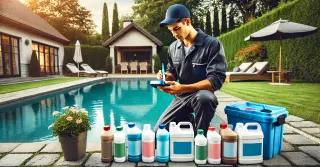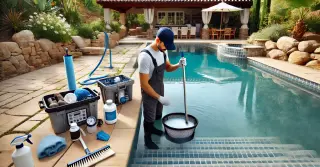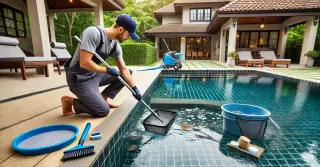Pool Chemical Balance Allenwood PA

Maintaining the proper chemical balance is vital for swimmer safety and pool health. Proper chemical levels prevent the growth of algae and bacteria, maintain clear, clean water, and protect the pool's surface and equipment.
- Maintaining Proper pH: Your pool's pH level reflects its acidity or alkalinity. Optimal pH levels range from 7.2 to 7.6. If the pH is too low, the water becomes acidic, which can cause skin irritation and corrosion of pool equipment. If the pH is too high, the water becomes alkaline, leading to cloudy water and scaling on the pool surfaces. Consistently testing and adjusting pH levels is vital for swimmer comfort and safety.
- Managing Chlorine Concentration: Chlorine is a key component in pool sanitation, killing bacteria, algae, and other harmful microorganisms. Optimal chlorine levels range from 1 to 3 ppm. Insufficient chlorine results in unsanitary conditions, promoting bacteria and algae growth. Excessive chlorine leads to skin and eye irritation and produce a strong chlorine odor. Consistently monitoring and adjusting chlorine levels ensures effective sanitation and swimmer comfort.
Managing Total AlkalinityTotal alkalinity is another critical aspect of pool water chemistry. Alkalinity stabilizes pH levels, avoiding sudden pH changes. The ideal range for total alkalinity is between 80-120 ppm.
- Stabilizing pH Levels: Proper alkalinity levels help stabilize pH levels, preventing rapid pH changes that irritate skin and damage surfaces. If alkalinity is too low, pH levels can fluctuate wildly, making it difficult to maintain a consistent balance. If alkalinity is too high, it can make the water cloudy and lead to scaling. Consistently monitoring and adjusting alkalinity levels is vital for a balanced and stable pool.
- Managing Calcium Hardness: Calcium hardness measures the dissolved calcium in water. Optimal calcium hardness levels are between 200-400 ppm. If calcium levels are too low, the water becomes corrosive, damaging pool surfaces and equipment. Excessive calcium causes scaling and water cloudiness. Consistently monitoring and adjusting calcium hardness is crucial for safeguarding your pool and maintaining clear water.
Proper Chemical Use and StorageUsing and storing pool chemicals safely is essential for both safety and effectiveness. Store chemicals in a cool, dry place, away from direct sunlight, children, and pets. Always follow the manufacturer's instructions for dosing and application.
- Accurate Chemical Measurement and Mixing: Precise measurement of pool chemicals is crucial for maintaining balance. Using incorrect amounts can disrupt the chemical balance and affect water quality. Always use a clean, dry measuring tool and avoid mixing chemicals directly. Mix chemicals in water if required, following the instructions carefully.
- Awareness of Chemical Reactions: Some pool chemicals can react dangerously when mixed. For instance, never mix chlorine and acid. Understanding these interactions prevents accidents and ensures safe handling. Store chemicals separately and handle each with care to avoid dangerous reactions.
Ensuring the right chemical balance in your pool is vital for a safe, clean, and pleasant swimming experience. By consistently testing and adjusting pH, chlorine, alkalinity, and calcium, you ensure optimal water quality.
Safe use and storage of pool chemicals improve the safety and longevity of your pool.




